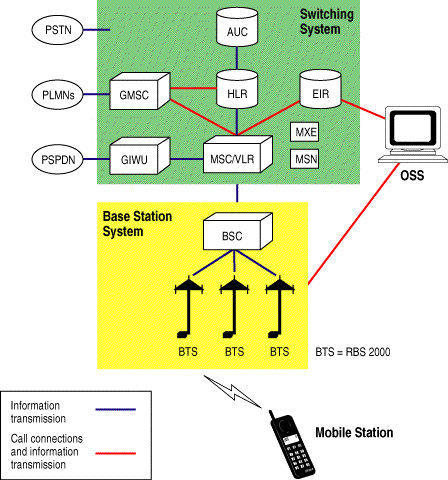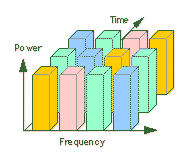
Global System for Mobile Communication
(GSM)
Throughout the evolution of cellular telecommunications, various systems
have been developed. None of these systems established standardized
specifications. As a result many cellular phones were not compatible
with certain networks and their use was limited. The GSM standard
was created to address these issues.
Basic History of the development of GSM technology:
Year
Event
1982
GSM formed
1986
Field Test
1987
Basic TDMA system adopted as access method
1989
Validation of GSM system
1990
Pre-operation system
1991
Commercial system start-up
1992
Coverage of larger cities / airports
1993
Coverage of main roads
1995
Coverage of rural areas
GSM uses a transmission mechanism very similar to that of TDMA and is the most widely used digital technology in the world. GSM digitizes and compresses data, then sends it down a channel with two other streams of user data. Each user is assigned its own time slot. GSM provides recommendations not requirements. It operates at either the 900 MHz or 1800 MHz frequency band.
The GSM specifications define the functions and interface requirements
of networks, but do not specify the hardware to be used. The
reason for this is to give hardware designers as much freedom as possible,
and at the same time give network operators the possibility to buy equipment
from different suppliers. The GSM network is divided into three
major systems: the switching system (SS), the base station system (BSS),
and the operation and support system (OSS). The switching system
(SS) handles call processing and subscriber related functions. The
base station system (BSS) performs all radio related functions.
The operation and support system (OSS) is the functional entity used from
which the network operator monitors and controls the system.
It also supports the basic maintenance of the system. The following
diagram illustrates the operation of a GSM network:

GSM has rapidly become the most widely accepted and adopted cellular phone standard in the world. There are over 150 GSM network operators in 86 countries around the world. Many GSM network operators have agreements with other networks, so that users can use their cellular phones when they travel to other countries.
The most important feature of GSM technology is the Subscriber Identification Number, known as a SIM card. A SIM card is similar to a credit card, but has an embedded microchip. The user's service provider programs the card with the subscriber's telephone number and billing information. The SIM card is then inserted into a GSM phone, where it carries all the information needed for the activation and validation of the telephone. When the user travels to any region that is covered by a GSM provider, the user can make or receive local, long distance, and international calls just the way they could at home using their country's wireless number. The charges for all the calls made and received appear on the subscriber's domestic bill.
Another important feature of GSM phones is their ability to compute data. Because GSM phones are digital, they can be connected to your laptop computer to send or receive e-mail, faxes, browse the Internet, and access your company's Intranet. GSM is an all digital standard, and for the consumers this means less static, clearer reception, and overall better audio quality.
To find out more about GSM and its use around the globe, visit the following sites:
Time Division Multiple Access
(TDMA)
Time division multiple access is a technology used in digital cellular
telephone communication to divide each cellular channel into three time
slots in order to increase the amount that can be carried in each channel.
TDMA technology is based on the fact that the signal has been digitized,
that is divided into pieces of data. The digital samples
(data) from a single transmitter are distributed along different time slots
in several bands at the same time. This is shown in the following
figure:

The following figures show the difference between standard cellular technologies, such as analog, and TDMA technology, in cellular transmission. The top figure shows the regular transmission of four cellular conversations. Each conversation is assigned individual channels. The bottom figure shows the use of TDMA technology in the transmission of the four different conversations. A single channel can carry all four conversations by breaking data into short fragments, assigning a time slot for each conversation, and transmitting synchronized timed signals.
Four Coversations - four channels

Four Conversations - one channel
![]()
TDMA technology offers several
advantages to subscribers over standard cellular technologies:
-TDMA increases the efficiency
of transmission. It can also transmit data, such as faxes,
e-mail, etc.
-TDMA increases battery life
and talk time because the phone only transmits a portion of the time
during conversations.
-TDMA is the least expensive
alternative for upgrading analog systems to digital.
-TDMA separates users in time,
reducing interference from other simultaneous transmissions.
The problem with TDMA technology is that each user is assigned a predefined
time slot. If the user moves to another cell, communication may be
lost
because time slots in that cell
may already be occupied. Furthermore, if all the time slots
in the user's cells are being used, the user will not receive a dial tone.
As a result of these limitations, subscribers may not have continuos coverage.
To find out more aboutTDMA technology,
visit the following sites:

Code Division Multiple Access
(CDMA)
CDMA is not a new technology. It has been used in military
satellite communication systems for decades. The use of CDMA for
civilian mobile radio applications is a recent development.
It was proposed theoretically in the 1940s, but its introduction in the
market came 40 years after. Commercial applications of CDMA
became possible because of two fundamental developments. One
was the creation of very low cost, high density digital integrated circuits,
which reduce the size, weight, and cost of the user's telephone to
an acceptable level. The other development was the realization that
in order to have multiple access communications, phones must be regulated
to their lowest transmission power to achieve an adequate signal quality.
After digitizing data, CDMA spreads the data out over the entire bandwidth (broadcast spectrum) it has available. Unlike the present analog system and other digital system that divide the available spectrum into narrow channels and assign one or more conversations to each channel, CDMA is a wideband spread spectrum technology that spreads conversations across a wide segment of the band spectrum. Each telephone or data call is assigned a unique code that distinguishes it from the rest of the calls that are simultaneously using the same broadcast spectrum. As long as the receiving device has the right code, it can pick its conversation out from all the other calls.
The digital wireless personal communication service (PCS) is expected to use CDMA widely in the United States. A group called PCS PrimeCo that includes NYNEX, Bell Atlantic, USWest and Airtouch Communications has announced plans for PCS systems that use CDMA technology.
CDMA is affecting the use of
cellular phones and personal communication services (PCS) in the following
ways:
-Improves the telephone traffic
capacity.
-Improves the voice quality
and reduces significantly noise interference.
-Reduces the number of dropped
calls due to hand-off failures.
-Provides reliable transport
mechanism for data communications, such as fax and Internet traffic
-Reduces the number of sites
needed to support any given amount of call traffic.
-Reduces operating costs because
fewer cells are needed.
-Reduces interference with other
electronic devices.
-Reduces potential health risks.
To find out more about CDMA technology,
visit the following sites. Qualcomm is a pioneer in the development
of CDMA networks: To
![]()
CDMA Versus TDMA
Since the
introduction of CDMA technology in the late 80s, there has been a lot of
controversy of what technology can offer better services for the user.
Supporters of CDMA claim bandwidth efficiency of up to 13 times that of
TDMA and 20 to 40 times that of analog systems. They also argue
that CDMA transmission is more secure and has better quality due to the
broad band technology used. The proponents of TDMA argue that
there have not been any major trials of CDMA technology. They
also point out that the bandwidth efficiency of CDMA technology will soon
be matched by advancements in TDMA. CDMA is likely to control
the digital wireless market in the long-run due to its numerous advantages.
However, TDMA technology will remain dominant for a few more years.
CDMA must be tested further in order to prove its advantages over TDMA
technology.